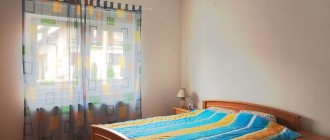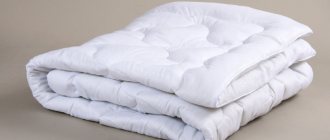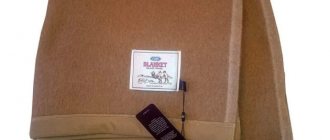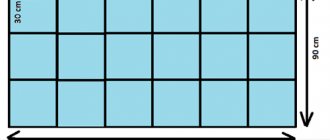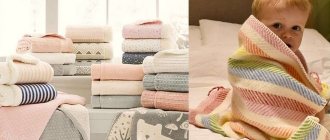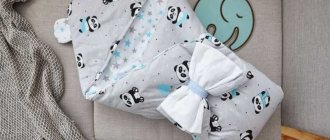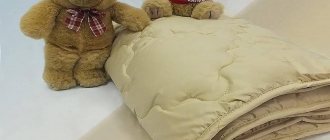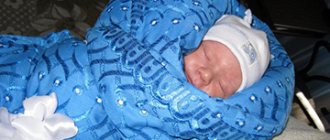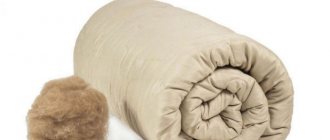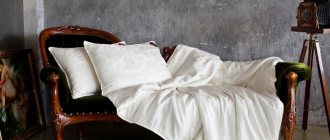The birth of a baby is a holiday that brings a lot of worries, because parents must choose clothes, toys, and bedding. Since the child will spend a lot of time in a crib or stroller, he should be surrounded by natural things. A blanket for a newborn, a sheet, a pillow, a pillowcase - all this should be light, soft, warm. You can find out about other characteristics below.
What types exist
Once on the bed linen market, you can get confused, especially for parents of their first child. The large number of types, colors, and sizes is impressive, but you need to choose several from all of them: summer, winter, demi-season. For babies up to six months old, it will be comfortable to lie in a cocoon blanket for newborns, which supports the unformed posture correctly.
Manufacturers offer the following products that differ in filler:
- downy;
- woolen;
- synthetic;
- linen;
- flannelette;
- silk;
- fleece;
- fur;
- cotton wool;
- calico;
- bamboo.
To save money, you can buy transformable blankets for a newborn - these things have 2 different sides: summer and winter.
To save money, you can make the right thing from available materials. For summer, a loose knitted blanket for a newborn, created by the mother’s hands, will be nicer than a store-bought one. To make it you need yarn, knitting needles and imagination.
A patchwork blanket for a newborn or “Bonbon blanket” can be made at home from leftover fabric. A good option is a piece in the patchwork style, which can be made in the form of a cartoon character, animal, car, decorating the upper part accordingly.
Summer
When it’s hot outside, you should not wrap your newborn in insulated clothes, this can cause a rash and skin problems, because overheating is more dangerous to health than freezing. The item should be light, made of fabrics pleasant to the touch, breathable, and hygroscopic.
Baykovoe
They are made from natural raw materials, so they:
- hypoallergenic;
- allow air to pass through;
- weightless;
- soft;
- beautiful;
- machine washable;
- serve for a long time;
- not electrified.
The cost of flannel clothes is low, which allows parents to save money.
Calico
Calico blankets are environmentally friendly and made from natural ingredients. Things made from calico have the following characteristics:
- a light weight;
- long service life;
- does not wrinkle.
Fleece
This knitted fabric maintains a comfortable temperature, making it suitable for newborns. The advantages include:
- light weight;
- ease of care;
- dries well.
Fleece blankets for babies attract dust and can cause rashes in newborns. To protect the child, you need to regularly empty the bedspread, ventilate it, and wash it.
Fillers for winter options
Children's winter blankets should have a very warm filling:
- A wool blanket is unsurpassed in this regard .
- Sheepskin models are very warm ; they can warm a baby on a walk even in the harshest winter.
- a blanket made of sheep or camel wool is perfect for winter weather . Such models are quite light in weight, so they will be comfortable for any newborn. Such blankets allow air to pass through perfectly, but at the same time retain heat inside, so you don’t have to worry about your baby getting cold.
A wool blanket can be either knitted or quilted. The only drawback of woolen models is that they can cause allergies, so you should first make sure in advance that there are no allergies.
- The fleece blanket is also very popular . This option is also considered very light, literally weightless. Such models are hypoallergenic and breathable; the baby under such a blanket will not sweat or overheat.
- For the winter, many people buy a cotton blanket for a baby, which model is also considered hypoallergenic. Cotton wool can retain heat, but at the same time it absorbs moisture. The disadvantage of such models is that they are quite heavy, which can create a feeling of discomfort for the baby. In addition, cotton wool can pill after washing and dry out for quite a long time, so cotton blankets are an excellent option only for walks. Many quilts have beautiful designs, the brightest and most interesting of them are patchwork ones.
- Also, many people buy a flannelette blanket for a newborn, since it is made only from natural materials. The bike does not cause allergies or irritation, it does not overheat the baby and does not cause sweating. In addition, the blanket on the bike dries quickly and is quite practical to use, it is light and comfortable, it can be used both at home in a cradle and when walking in a stroller.
- For the winter, many people buy a warm down blanket ; it is very light in weight and warm, but not hypoallergenic, since down is a natural material. Such a thing needs to be changed as often as possible - at least once every six months.
Winter
The main indicators for winter clothes are warmth and breathability. In winter, it is easy to overheat your baby, because a winter blanket for a newborn is designed for sub-zero temperatures, and using it indoors is not cost-effective.
Young parents can look at the double-sided bedspreads that are used in winter and summer. Transformable blankets for newborns are a godsend for thrifty people. When buying such a thing, you should determine the size correctly, because it will be used for more than one year
Woolen
They are made from camel or sheep wool. There are also goat products and llama-alpaca products. These things are very warm, so you shouldn’t use them in the summer. Wool blankets for newborns in the form of a quilted bedspread are a better option, because the wool is distributed and fixed evenly, does not cake, and does not bunch up. Advantages:
- light weight;
- heat;
- long service life;
- hygroscopicity;
- allows air to pass through.
If a child develops a rash after using a woolen product, it should be changed immediately. A sheep's wool blanket, among all similar things, is the most inexpensive product. Since natural wool is used, there is a high probability that moths will appear.
Down
The down of waterfowl is used as a filler for such bedspreads. The blanket can be made of swan, goose, or loon down. Downy things are:
- lightweight, for warm weather;
- cassette for cold weather;
- demi-season bedspreads for the spring-autumn period.
Characteristics:
- light weight;
- allows air to pass through well;
- warms well.
A down-based blanket should be used at a temperature of 16-18 degrees. In warmer rooms, its use may result in overheating. The big drawback of things made from fluff is that they contain quite a nutritious environment for microorganisms that can cause allergies.
Down is one of the fillers that is used in transformable blankets, insulating the winter side, which allows things to transform. Poor air circulation caused by tight padding can cause your baby to overheat, so be careful.
Synthetic
They are made from padding polyester, holofiber, isosoft, and comforter. They are harmless, have different shapes and sizes. There can be standard geometric shapes, in the form of animals, transformers. Most parents prefer natural materials, but they can cause allergic rashes, so for such cases there is a synthetic blanket for newborns. Advantages:
- hypoallergenic;
- light weight;
- ease of care.
- The disadvantages of artificial fillers are that they do not allow air to pass through well, there is a high risk of overheating, and they do not allow enough moisture to pass through.
Bamboo
Advantages:
- do not cause allergies;
- pleasant to the touch;
- antibacterial;
- do not spoil the appearance from numerous washes;
- serve for a long time.
The disadvantage can be considered high cost.
Cotton
Natural material – cotton – is used to fill things. Characteristics of cotton products:
- warms well;
- environmentally friendly;
- hypoallergenic;
- serve for a long time.
Flaws:
- heavy weight;
- takes a long time to dry;
- difficult to wash;
- absorbs odors;
- gets into clumps.
A wadded cotton blanket is not suitable for everyday use.
Quilted
A practical type of bedspread in which the filling is fixed with threads to reduce the risk of it moving out and clumping into lumps. In quilted products, the filling is sewn to a cover made of natural or artificial material.
Is the baby warm?
First of all, the blanket should provide good protection from the cold. Models with cotton filling are often not recommended for children. Such a product cannot be washed; it is difficult to find a dry cleaner that will undertake to put it in order. You can immediately reject this filler, and then bitterly regret your decision.
We recommend: How to choose a comfortable mattress for a double bed that suits both?
In many cities in winter, problems with heating often arise: either the steam supplied to the radiators is too cold, or the pumping station will fail in severe frosts. It's cold for both adults and children. This is where a cotton blanket will help you out. It may be heavy and difficult to care for, but this model will save your baby from the cold. Buy your baby such bedding, and no mistakes of the management company will make him freeze.
If your apartment is constantly cold, buy a wool blanket. It is hygroscopic and absorbs sweat well, but when purchasing, you need to touch the product and determine its cruelty. The wool must be well processed so that it is not itchy and does not contain splinters, thorns and other foreign inclusions. If you are not buying a woven blanket, but a cover with stitched wool filling, pay attention to the label. The density of the stuffing determines how warm the baby will be under such a blanket. For apartments with poor heating system performance in winter, you need to stay at 420 g/m2.
Advice
When choosing a wool blanket, focus only on softness and warmth. All information about radiation protection, the healing effect and the effects of lanolin from the hair of various animals on the skin is a common advertising gimmick.
Wool is considered a light filler, but if you want your baby to be warm and not feel the weight of the blanket at all, choose a model made of holofiber or padding polyester. These materials can be washed and do not harbor harmful insects. If you are going on a trip, the product can be compactly packed, it will not take up much space, and its weight is almost imperceptible. Such things can be safely packed and sent to the mezzanine for the summer; moths won’t eat them.
What to look for when choosing
Blankets for newborns are an important attribute of the crib. It is used as a softening pillow when the child begins to stand up, like a toy, hiding under it. The bedspread should be natural, pleasant to the touch, and not cause allergies. Characteristics that you need to pay attention to when choosing:
- Seasonality. A summer item for the warm season, a winter item for the cold season. If you use one thing in winter and summer, the risk of overheating or hypothermia increases for the baby.
- Safety. The bedspread should not contain toxic substances, dyes used to soften fabrics to give them a marketable appearance, or questionable fillers.
- A temperature that is stable in the room.
- The filler should not become a breeding ground for the development of microorganisms. Among such materials are fluff and cotton wool.
- Size. The bedspread must be selected based on the size of the crib. A thing that is too big will crumple and create discomfort for the baby, a small thing will slide off.
- Comfort of use. Soft blankets for the crib are preferable to hard and hard ones. You also need to make sure that the thing does not prick - the baby will probably not like the “biting” blanket.
- Ease. Since this is a thing for a child, it must fit so that the child can take it off on his own if he gets hot or the parents don’t arrive in time.
- Hypoallergenic. This is one of the most important parameters, since the baby will spend more than 12 hours on the blanket.
- Moisture exchange. In an unforeseen situation, the item should dry quickly after washing.
- Air permeability is an important parameter for a baby - his body must breathe.
The listed properties depend on the filler, and only softness depends on the upper fabric.
How to cover a baby so he doesn't get too hot
In a cold apartment you need to wrap your baby up warmer, but summer comes and adults exchange woolen coats for light dresses. The baby also needs to get out of the hot shelter. For a warm period, a blanket made from a flannelette is perfect for a child. The big plus of this product is that it can be washed frequently. Natural fabric with soft brushing does not irritate the baby’s skin, he can play and crawl on such a bedding, there will be no harm to his body.
When you go for a walk in the forest or park, take a flannelette blanket with you. It will not take up much space in your bag and will not burden you with excess weight. In the clearing, spread a blanket on the grass and lay the baby on it. Don’t worry that blades of grass and grains of sand will get tangled in the fabric - at home you can throw the blanket in the washing machine, then hang it to dry, and it will be as good as new.
We recommend: Pros and cons of orthopedic springless mattresses
If the summer is cool, you will also need a wool blanket, but it should be different from the winter version. Choose a filler density of 200 g/m2; your baby won’t get too hot under this. From time to time, approach the child and touch his neck. If you feel sweat, you have wrapped your baby too warmly, remove the blanket and cover him with a duvet cover, sheet or light blanket.
The debate about which blanket is best for a baby is useless; the best option is to keep him neither hot nor cold.
Recently, bamboo blankets have appeared on sale. If bamboo was used in the manufacture, then the baby will be very comfortable under such a shelter: not hot in the summer, and not cold in the winter. The material does not cause allergies and is easy to care for. There is only one drawback: such products are expensive.
Common sizes
The bedspread comes in different shapes, colors, and sizes. To buy a product that will be comfortable for your child, you should measure the crib before visiting the store. The size of a blanket for newborns should be slightly larger than the sleeping area.
If the baby is more active, there is a high chance that he will cover himself completely if the blanket is large. To prevent this, there are side clamps. A short or narrow blanket will constantly slide down, revealing the baby. You should choose according to age and height.
How to properly wrap a newborn
Choosing a blanket is half the battle, because you still need to learn how to wrap a child in it. You can read below how to do this correctly, but now a few tips that will simplify the wrapping process.
Useful tips:
- wrapping your baby in a square-shaped blanket is easier, because creating symmetry becomes an easy task;
- the item should have a small margin in size - 80x80 or 90x90 cm for checkout, for further use 90x120 or 90x140 cm;
- wrapping a child in thin material is easier;
- To prevent the baby from opening up during a walk, you can first wrap him in a diaper;
- In winter, a newborn should be wrapped in two blankets.
How to properly wrap a newborn in a blanket for a walk:
- spread the dressing tape on a flat surface and place a blanket on it diagonally;
- place a diaper with lace on top, orienting the pattern towards the head;
- lay the baby diagonally, checking that there are no folds under the back;
- the upper corner should be rolled up around the head to make an air pocket;
- press the left handle to the body, fixing it with the right edge;
- Tuck the rest of the material under the back, avoiding folds;
- lift the bottom corner and tuck it behind the baby’s right shoulder;
- Wrap the baby in the left corner, securing the envelope with tape.
Baby's sleeping area
What should you buy for a newborn's crib first, how much will it cost, what is included in the complete list - these are the very first questions of future parents even when they first learned about the upcoming addition. Some people don’t think at all about a place to sleep, knowing that the baby will lie calmly in the first months in a stroller or in the arms of the mother, while others select a quality attribute with excitement and anxiety.
Immediately after birth, the baby sleeps about twenty hours a day. In order for its development to proceed harmoniously, proper sleep should be organized. The industry that sells all the necessary things for children is very developed today. It can offer a large selection of cribs, cradles, orthopedic mattresses, warm ones for winter or light thin blankets for babies, flannel or cotton diapers, and special bolsters that should be placed under the back of the baby. The key criterion in choosing the right product is the safety of the baby in the crib.
Important! When purchasing certain accessories, there is a possibility of buying something that will lie idle for a long time. Children's pediatrician and candidate of medical sciences, Evgeniy Komarovsky, assures that when asked whether a baby needs a pillow in a crib, the answer is clear: it will not be useful until the age of two. This attribute, according to the doctor, should not be purchased in order to avoid sad consequences.
It is necessary to purchase new furniture at least 2 weeks before the birth. The specific smell will have time to disappear within 14 days and will not cause discomfort to either mother or baby. It is important that the crib is made from absolutely natural raw materials; the product must have a quality certificate. The presence of sharp corners on the structure is a sign of a low-quality product that is not worth buying.
What to look for when choosing a sleeping place:
- frame;
- the base of the crib and its appearance;
- mattress composition;
- what are the sides and blanket made of?
- bed linen material.
What you can do with your own hands
You can make blankets for a newborn with your own hands. To work you will need fabric, a sewing machine, stuffing, decorations and imagination. One side of the finished product should be made of cotton fabric so that the child is comfortable.
To make a lace bedspread, just add lace fabric to one corner. The cutting and sewing technique is the same as for a regular product of this type. You can make a pattern on the outside or buy a ready-made one in a store and sew it on.
Making a quilt for newborns with your own hands is also easy; you can use master classes. It is better to use artificial material as a filler - it is easier to stitch. Another option is a high-quality sewing machine.
If knitting has become a habit, then a blanket for a child will not be a problem. It is better to make the inner side from a fabric that is pleasant to the touch, because a knitted one will leave imprints on the baby’s sensitive back. You can create any patterns and shapes with knitting needles. Knitted blankets with bears are very popular.
A good option for thrifty housewives is to sew a patchwork quilt. It can be made from small pieces of fabric, sewn in a specific sequence to create patterns.
How to choose the right blanket for your baby
To understand which blanket is best to choose for a newborn at discharge or in a crib, you should consider and compare the most popular options, as well as highlight the main selection criteria. If the product has a cover, it must be made of high-quality durable and natural fabric: cotton or silk. It is important to check all seams; the filler should not come out. The material should be soft and not emit unpleasant odors.
The warmth of the product must correspond to the temperature regime - the baby should not freeze or overheat.
The right blanket or blanket will give your baby coziness and comfort while sleeping. However, to do this they must meet certain requirements:
- made from hypoallergenic materials;
- easy to wash, dry quickly and have a durable color;
- use only soft, delicate and lightweight fabrics;
- good air flow;
- be highly hygroscopic: easily absorb moisture and simultaneously release it into the environment;
- the correct selection is important depending on the time of year or the average temperature and humidity of the room;
- the level of warmth is indicated using dots on the packaging (from 1 to 5 - the more dots, the warmer);
- Dimensions should be selected based on the purpose:
- for a crib: 110 x 140 cm or 110 x 135;
- for stroller: 90 x 90.
Both hypothermia and overheating are dangerous for a baby. Therefore, for the summer period it is better to select light, delicate and maximally breathable fabrics, and in the cold season, denser and fleecy materials are needed.
For discharge
More often, very comfortable envelope blankets are used to discharge a baby from the hospital. They vary depending on the modification:
- buttoned;
- locked;
- on the buttons.
When choosing a blanket for a newborn, carefully monitor whether the child has any allergic reactions.
They are made from various materials and can be:
- fur;
- woolen;
- fleece;
- velor;
- jacquard;
- satin;
- silk;
- knitted.
Such an envelope should not only be beautiful, but also convenient, practical, reliable, and also meet all hygienic requirements.
For summer, you can choose a lightweight envelope, decorated with elegant ruffles and luxurious bows. A transformable jumpsuit made of fur or sheep wool is ideal for the winter period.
If the baby is born in the summer, a light option during the first months is sufficient.
To bed
The crib blanket or blanket must match the size of the bed. Standard sizes are:
- 100 x 135 cm;
- 110 x 140 cm;
- in a cradle - 90 x 90 cm.
To prevent the blanket from slipping and the child from freezing while sleeping, they came up with models with latches:
- buttoned;
- with ties;
- Velcro;
- on the buttons.
To make it easier to understand which size to choose, you should start from the size of the crib when choosing a blanket to fit its dimensions.
The edges of a large blanket can be tucked under the mattress.
Is it necessary to choose a blanket for a newborn’s crib not only depending on the season? Of course, you should pay no less attention to the temperature and humidity of the room.
In the stroller
For walks in a stroller, you should choose an option depending on the season. A knitted blanket, fleece or patchwork, would be ideal for summer. Overheating of the baby is not desirable, as is hypothermia. In winter, it is good to use a transformable blanket; it does an excellent job of protecting the baby from frost and wind.
Do not choose one that is too small – it will be impossible to cover your baby completely. You can’t choose too big - this will interfere with the child’s movement.
Summer
The best baby blanket for summer is made from silk, cotton or bamboo. They help maintain an ideal microclimate in the baby's crib and are very easy to care for. Silk is strong and durable, while bamboo has high bactericidal properties and is hygienic.
The blanket should provide warmth, but at the same time allow the skin to breathe.
Baykovoe
The most common material for children's blankets and blankets is cotton. High quality and reliability at affordable prices. The products are very light, pleasant to the touch and breathable. They are highly wear-resistant and easy to care for: they wash well and dry quickly. They will perfectly warm your baby on a cool summer day or the mid-season period. Babies feel comfortable and protected, and parents are confident in the ideal quality.
The material must quickly absorb moisture and evaporate it. Avoid harmful toxic materials.
Calico
Calico is a 100% cotton fabric, the most famous and traditional in the manufacture of bedding, does not cause irritation and allergies. Very practical and fairly inexpensive, but quite dense and not very soft. Well suited for summer blankets or as a cover for wool or padding polyester filling in winter blankets.
When purchasing, consult the seller and ask him about care.
Fleece
Fleece products are perfect for warm summer walks. They are incredibly light, soft and tender. However, they collect dust very well, which can become a source of allergic reactions. To avoid such situations, you should simply wash such products more often. In addition, they wash perfectly and dry very quickly.
Children's bedding needs constant washing, so avoid options where it will be a big problem.
Winter
It is best to choose blankets for the winter from natural wool or down. However, it must be remembered that such fillers can cause allergic reactions. Models made from synthetic fabrics fully comply with all criteria: ecofiber, holofiber or other down substitutes. It is better to avoid fillings made of cotton wool or padding polyester.
Do not buy cheap market products, it is better to purchase it in a company store, always with a quality certificate.
Woolen
A woolen blanket is perfect for walking in spring and autumn, and is also indispensable for cool and damp rooms. It is very warm, soft and comfortable, perfectly absorbs and evaporates moisture, while remaining completely dry.
Remember that one option is not enough - you need at least two. One is to use at home, the other is to use while walking.
Camel wool blankets have the ability to self-clean. Sheep, goat and merino wool is also used as filler, which is tightly stitched into the cover. This technology will allow the wool to be evenly distributed throughout the blanket, and when washed it will not form a lump. Original blankets are knitted from wool yarn, both for walking and for the crib.
Down
This blanket is ideal for walking in winter. And also in spring and autumn, when the air temperature does not exceed 16-18 degrees. Lush and very soft products are made from loon, swan or goose down. Down allows air to pass through perfectly and retains moisture well. The main disadvantages are that fluff does not straighten out well after washing and can cause allergies.
Buy blankets that are a little larger in size for the next season, as the baby will grow during this time.
Synthetic
Soft, light and delicate synthetic products have reasonable prices and fairly high quality. They are easy to care for and retain heat well. However, due to their low hygroscopicity, they retain moisture, which can cause sweating in children.
Don't buy blankets with large, easy-to-fall out piles and lots of toxic dyes.
The following are used as fillers:
- padding polyester;
- holofiber;
- ecofiber;
- Thinsulate;
- comfort;
- swan down substitute;
- silicone fiber.
Bamboo
Blankets of this type appeared on the market relatively recently, but they are in great demand. Bamboo has natural antibacterial properties and does not provoke allergic reactions. These blankets are very light, breathe well and absorb moisture. They can be used at any time of the year. Bamboo fiber is long-lasting and reliable; it allows you to maintain optimal temperature and moisture balance. Even the high cost is justified by the impeccable quality.
Any product that comes into contact with the child’s body must be made in accordance with certain requirements so as not to harm him.
Cotton
Filling with cotton wool for a baby blanket is not the best option. It clumps into lumps, especially after washing, and absorbs odors and moisture. Such blankets take a long time to dry and cause maintenance problems. However, cotton wool remains a popular filler. Such blankets are wonderfully warm, absorb moisture and are environmentally friendly. Used for walking in strollers and sleds.
Warm filler. Non-allergenic, breathable. But it dries poorly, clumps into clumps, losing its shape and all its useful qualities.
